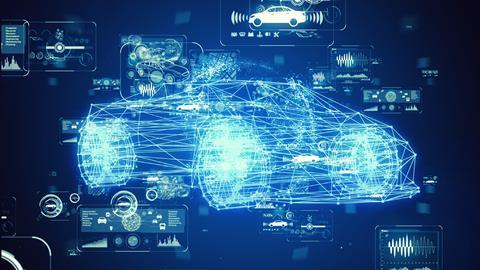However, the sector still needs to forge affordable partnerships with vehicle manufacturers in order to use connected car data to improve the FNOL and claims experience
The rise in connected vehicles presents “a big opportunity” for the insurance sector to act as a “guardian angel” for its customers as “proactive FNOL [starts] to take over from reactive FNOL”, said Jonathan Hewett, chief executive at Thatcham Research.
Speaking as part of a panel discussion on the second day of the ABI’s annual motor conference, this year held online on 5 November, Hewett explained that insurance is the “the best use case” for connected car data.
He said: “There’s a big opportunity here for the insurance industry to position, not as Big Brother when it comes to data, and I think this is some of the challenge that telematics had in the past, but [as a] guardian angel and to be there for the consumer when something goes wrong - not in an analogue way, but in a digital way, knowing that an accident has happened and proactive FNOL starting to take over from reactive FNOL and being smart about what data can be captured from the vehicle’s connectivity and how that can be fed seamlessly into insurer workflows.”
However, the main challenge with this approach lies in the current lack of affordable collaboration between vehicle manufacturers and insurers, added David Williams, managing director of underwriting and technical services at AXA Insurance. He said that often, getting hold of the necessary data comes with a hefty price tag.
“Whilst partnering with motor manufacturers sounds a great idea, and clearly we need to do that, there is often a price involved, therefore I think as well as trying to make arrangements with motor manufacturers, we probably need some legislation to compel the provision of certain information so that we can offer those proper facilities to our customers,” he explained.
“The worst outcome from our perspective would be for one of our customers to be involved in a serious accident and the first thing we know about it is a month or so later when the vehicle has already gone into a prestige main dealer’s own repair shop at a hugely inflated hourly labour rate and no-body’s done anything about assessing the personal injuries involved. So, it is really, really important that we get access to that data.”
Williams added that if insurers can get their hands on connected car data, “it certainly should transform claims”.
“The cars of the future are effectively computers on wheels and with high definition video, accelerometers, all sorts of devices measuring all sorts of factors, it should really speed up claims processing,” he added.
Partnership potential
With this possible problem in mind, Hewett told the 180 attending online delegates that Thatcham Research is currently exploring how to embed insurance partnerships with vehicle manufacturers as a “strategic imperative”.
He said: “The number one thing that [Thatcham is] doing, and this is a strategic imperative, is to get much closer to vehicle manufacturers, to get ahead of some of the new technologies that are going on to vehicles so we don’t catch a cold, as we have done in the past, with core new technology like keyless entry or ADAS systems needing calibration with even the smallest amount of damage.
“So, really understanding what the technology looks like, the vehicle road maps look like, the types of technology that are being developed by tier one, tier two manufacturers and suppliers, so that we can understand the claims challenges in the future.
“Much of that is about vehicle design and not putting the very expensive sensoring, radaring, camera technology just behind bumpers at the points we know are most frequently damaged. That connection between the industries and then understanding the value for each of the industries is a really important thing.”
Underwriting nuances
On the underwriting side, Williams added that insurers are “learning all the time” about the opportunities presented by connected cars and the associated data and that they certainly aren’t “lagging behind”.
In particular, the use of connected vehicles helps to improve communications between insurers and their customers and can produce more regular touchpoints that the typical once a year quote experience.
Connected cars can also influence the introduction of new propositions, Williams said – these could be based on location or nearby infrastructure, for example to advise drivers to avoid accident hotspots when driving in certain areas, or to advertise spaces when approaching a car park.
Juxtaposed with these benefits, however, are also risks. Alerts for car parking spaces or to avoid traffic and hotspots may be useful, but they could also distract the driver if they are required to look at a screen, which could have safety implications. Cyber risks are likely to become more prominent too.
Around underwriting specifically, Williams spoke about how ‘over the air’ updates can be problematics for insurers – if an update occurs during the policy term, then the car could – in fact – transform to be very different to the vehicle that was insured at the start of the policy.
Williams said that insurers needed to receive data – that isn’t “strangled by manufacturers” – in a timely way.
Cultural challenge
Hewett added that the main issue surrounding connected cars is not technology-based, however. He believes that the problem is more of a “cultural challenge, organisational challenge” in terms of equipping staff with the necessary skills to ensure they are comfortable handling and understanding connected car data. This includes looking at working practices, workflow integrations and partnerships.
Getting this right could lead to a “suite of opportunities”, Hewett said, as the industry can take advantage of static data models becoming more dynamic and digital.
Alongside Hewett and Williams in the panel discussion was Srikanth Madani, industry advocate, worldwide financial services at Microsoft Corporation. The session was chaired by LV= GI’s head of motor underwriting, Alexandra HC Borgnis.

Hosted by comedian and actor Tom Allen, 34 Gold, 23 Silver and 22 Bronze awards were handed out across an amazing 34 categories recognising brilliance and innovation right across the breadth of UK general insurance.





















































No comments yet